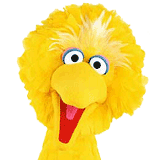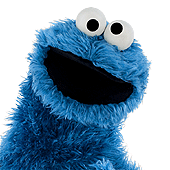Oscarfan
Well-Known Member
- Joined
- May 2, 2008
- Messages
- 7,530
- Reaction score
- 3,960
The full resource video's coming out tomorrow.
And here's an article about it.
‘D’ Is for Divorce: Big Feelings on Sesame Street
In early 1992, a census report predicted that 40 percent of children would soon live in divorced homes. As one of the most famous children’s television programs in the world, Sesame Street was determined to take on a topic most kid’s shows wouldn’t touch. They cast Snuffy, a.k.a. Mr. Snuffleupagus, for the part of child divorcee.
With a team of its best writers, researchers, and producers, a segment was scripted and shot. It went through a half-dozen revisions, with input from the foremost researchers in the field. And on a typical sunny afternoon on Sesame Street, the furry, red, elephantine muppet known as Snuffy prepared to drop the bomb on his loyal preschool viewers.
“My dad is moving out of our cave,” he confides to Big Bird one afternoon, distraught after knocking over a house built of blocks. “I’m not sure where,” he continues, crying. “Some cave across town.”
Big Bird, naturally, is horrified. “But why?” he asks his friend.
Snuffy blinks his long, dark eyelashes, and pauses. We know what’s coming. Well, he explains, “because of something called a divorce.”
You can pretty much guess where it goes from there: Gordon explains why divorces happen. Viewers learn that sometimes divorce can be “for the best.” We are assured that Snuffy and his sister Alice will always be loved. And yet when Sesame Street tested the segment on preschoolers, just weeks before it was scheduled to air, it was nothing short of a disaster. The children didn’t know where Snuffy was going to live. They didn’t think his parents loved him. Some worried their own parents might get a divorce. They cried.
“It was really the first time we’d produced something, put all this money into it, tested it, and it just didn’t work,” says Susan Scheiner, a longtime Sesame researcher, who worked on the segment. “We thought we had it. We thought this was really revolutionary, and then it was just bad.”
Sesame Street killed the show, and for the two decades since, producers have avoided the D-word on air — until now.
For the past two years, a concentrated team of researchers, writers, and producers in the outreach department of Sesame Workshop (the nonprofit that operates Sesame Street) have been working on a new version of that segment, replacing Snuffy with the sparkly pink fairy known as Abby Cadabby (whose parents, we learn, have been divorced for some time). On Tuesday, the Workshop will debut the 13-minute segment online — part of a massive multimedia kit called “Little Children, Big Challenges: Divorce” that includes a storybook (“Two Hug Day”), a guide for parents, and an app, funded as part of a larger initiative geared toward military families. The segment itself won’t air on TV — it’s among Sesame’s “targeted” programming aimed at specific populations — but it will tackle divorce directly, in a way producers hope is accessible, understandable, and, well, not quite so scary.
“We want kids to understand that they’re not alone, and that it’s not their fault,” says Lynn Chwatsky, Sesame’s vice president for outreach, who oversaw the project. “These kids love and adore Abby. So to know that she’s going through something similar to them, something challenging, it’s like, ‘Wow.’ It makes it OK to have a whole range of feelings.”
“Big feelings” is a theme of the video segment, which features Abby, the happy-go-lucky fairy-in-training, at its center. Viewers know little about Abby’s parents up until now, so when she and some friends decide to draw pictures of their homes, Elmo and Rosita are surprised to learn that Abby has not one, but two houses. “This one is where I live with my mommy,” Abby proclaims confidently, holding up her crayon drawing, “and this one is where I live with my daddy.”
The reason? Well, you know the reason. “Divorce means that Abby’s mommy and daddy aren’t married anymore,” Gordon explains.
It’s sweet, and certainly better late than never. Because, while the statistics may be dire — more than a million children have parents who divorce or separate each year; many of those breakups happen in the preschool years — researchers say that resources intended for preschool-aged children are still shockingly scarce. No, children of divorce won’t necessarily be more screwed up than their non-divorced peers, but they can be — if they don’t get the right support from the adults around them. So information for parents and children alike is key.
“I think the biggest challenge for parents is that they are overwhelmed themselves,” says Robert Hughes, a professor of human development and family studies at the University of Illinois, Urbana-Champagne, and one of four independent consultants who advised on the project. “So it’s managing their own emotions, and then figuring out how to deal with their children’s emotions. That’s where Sesame Street comes in — it gives you a tool.”
Most viewers may not know it, but Sesame Street was the first show to use empirical research as part of its programming. Now in its 44th season, what that level of research means is that producing shows for Sesame Street can take months, if not years — involving dozens of experts, researchers, and psychologists, as well as impeccably-sourced advisory teams who are asked to serve as critics. Big Bird as political pawn and Elmo sex scandal aside, it’s a model that’s allowed the show to tackle subjects that, as 30-year-Sesame Street veteran Lewis Bernstein puts it, “sometimes you’d think you wouldn’t want to touch with a ten-foot pole”: race, adoption, love, pregnancy, incarceration — even death. When, in the early 1980s, the longtime cast member (Will Lee) who played Mr. Hooper died suddenly, Sesame Street faced up to the change — explaining that Mr. Hooper wouldn’t be returning to the show (or his store). “If we left it unsaid,” the executive producer reasoned at the time, “kids would notice.”
Last month, in the wake of Hurricane Sandy, the show re-aired an episode in which Big Bird’s nest is devastated by a storm. “A lot of people want to shield kids from the tougher issues,” says Chrissy Ferraro, a writer on the show. “My feeling is, the more information the kid has, the better.”
And divorce? Sure, it will probably alarm some parents to see muppets talking about such an emotional minefield. Studies on the benefits of Sesame Street could fill a bookshelf, and yet the show has always faced criticism, over everything from Cookie Monster’s pipe smoking (ah, the early days) to Oscar the Grouch’s mood swings (yes) to Abby herself, who — when she became the first female muppet to join the show in a decade, in 2006 — some believed was too “pink.”
But these days, divorce is simply a reality — “a fact of American life,” as one dad involved in the project put it — and continuing to ignore it would be a conspicuous omission. And so, two decades post-Snuffy debacle, the outreach team eagerly took a second crack at the topic. Admittedly, it wasn’t simple. Researchers wondered which muppet had the best personality for the role, and what kind of vocabulary would be best to get the message across. While the goals were simple — help kids understand that divorce is never their fault, that mom and dad will still love them — accomplishing them was another story. “TV can be a very impressive teacher — if it’s done correctly,” says Dorothy Singer, the cofounder, with her husband, of the Family Television Research Center at Yale. Of course, there’s lots to it: “Pacing is important, repetition is important, the clarification of ideas is important.”
First, of course, there was the character to think about. Had Snuffy’s demeanor made him a more somber force? He’s got those big eyes, that deep voice, those long, weepy eyelashes. Would a pink, bubbly fairy be a better match for such a serious topic?
Then there was the crucial distinction of timing: Snuffy had experienced his divorce in the present; he was upset, angry, crying. His emotions were raw. But Abby would reveal her story as something that happened in the past — an important distinction, say researchers, to show kids that she’s made it to the other side.
But perhaps the most critical difference had to do with audience: targeting only the kids who are experiencing a divorce, or whose parents wanted to make the point of downloading the content. In other words, there would be no divorce segment catapulting into your living room unannounced. Sesame Street almost made that mistake before. But then, in 1992, there was no alternative online method for targeted or voluntary delivery of the segment, as opposed to broadcast.
The initiative will be available this week, and yet in testing programs this past March, kids seemed to get it. Huddled into conference rooms at Sesame Street’s midtown New York headquarters, preschoolers were broken into small groups, accompanied by a parent who’d viewed the DVD already. Each parent in the room was either divorced or separated.
This time, there was no crying. The kids knew exactly where Abby lived. They smiled. As Gordon and Abby sign off with a duet — repeating, again and again, “They live in different places but they both love me” — kids hummed along.
“It’s not her fault,” one 7-year-old offered.
“It made me feel happy, because Abby told Gordon a lot of her mixed feelings,” said another.
It’s wasn’t magic, exactly — but it felt like it had the blessing of a certain pink fairy.
”This isn’t an easy topic, but that’s the beauty of muppets,” says Chwatsky. “They can do things that even some grownups can’t.”

 Welcome to the Muppet Central Forum!
Welcome to the Muppet Central Forum!.jpg) Christmas Music
Christmas Music Macy's Thanksgiving Parade
Macy's Thanksgiving Parade Sesame Street debuts on Netflix
Sesame Street debuts on Netflix Back to the Rock Season 2
Back to the Rock Season 2 Sam and Friends Book
Sam and Friends Book Jim Henson Idea Man
Jim Henson Idea Man Bear arrives on Disney+
Bear arrives on Disney+
 if only...
if only...